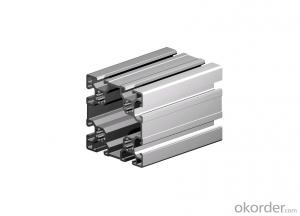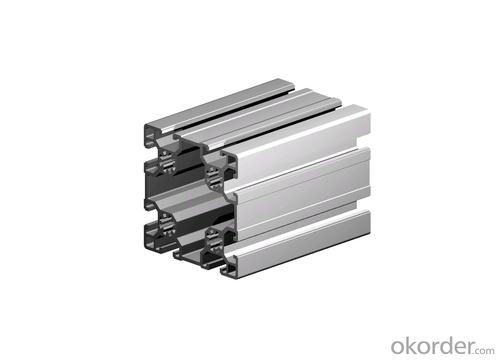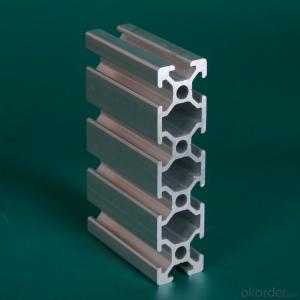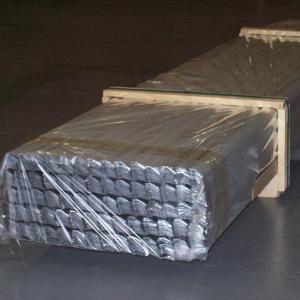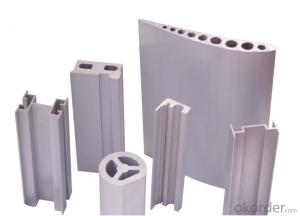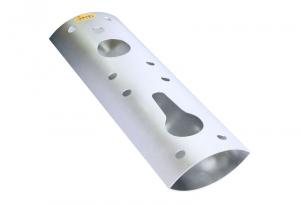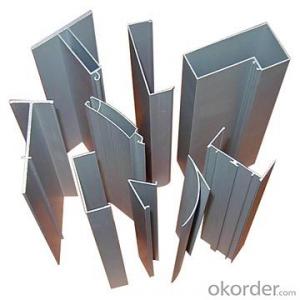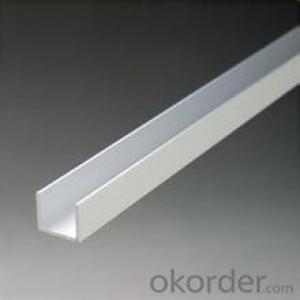Aluminum Fascia Profiles for Industrial Aluminium Extrusion Applications
- Loading Port:
- Shanghai
- Payment Terms:
- TT OR LC
- Min Order Qty:
- 1 m.t.
- Supply Capability:
- 50000 m.t./month
OKorder Service Pledge
OKorder Financial Service
You Might Also Like
Specification
Product Description
Product Name | Aluminium Extrusion Profiles For Industrial Application |
Alloy | Al 6063 T5 /T6 or 6061 T4/T6 or as customers' need |
Surface | Aluminum profiles of mill finish, powder coating, anodizing, polishing, sand blasting, electrophoresis and wood color. |
Profile shape | According to drawings or re-design as requested or market needs. |
Price | Based on Aluminum Ingot Price + Process fee |
Payment term | T/C T/T 30% deposit and 70% pay against copy of B/L |
Certificate | ISO9001 ISO14001 |
Warranty | 1. GB5237-2008 equal to EN12020-1.2(2001); 2. Within 15 years without powder peeling off; |
Product Advantages
1. Plenty of surface treatments for your choice, for example oxidation, electrophoresis and static powder coating, etc.
2. Strict control for surface finish, very little scratch.
3. Accurate mold as well as accurate size.
4. Standard alloy composition
5. Both ends of the profiles are very plain and with no burr.
FAQ
1. What is your main product?
We can supply the aluminium complete system, including aluminum billets, aluminum profile for windows and doors, aluminum for curtain wall, alumimun framwork, and kinds of aluminum windows and doors.
2. What’s your price?
The price is based on buyer's specific requirement, so please provide below information to help us quote exact price to you.
3. What is your payment term?
30% - 50% down payment, the balance payment against, and L/C is available.
- Q: What are the safety features of aluminum profiles in construction?
- Aluminum profiles are a popular choice for construction due to their range of safety features. They are both lightweight and durable, making them easy to handle and install while still providing structural integrity. This reduces the risk of accidents or injuries during the construction process. Furthermore, aluminum profiles are non-combustible, meaning they do not contribute to the spread of fire. This is crucial for ensuring the safety of occupants and minimizing fire-related hazards. In addition, aluminum profiles have excellent corrosion resistance properties. They are naturally resistant to rust and decay, allowing them to withstand harsh environmental conditions and maintain their structural integrity over time. This is particularly important in coastal or humid areas where corrosion risk is high. Moreover, aluminum profiles can be designed to incorporate safety features such as non-slip surfaces or grooves for enhanced grip and stability. This is especially beneficial in applications where slip and fall accidents may occur, such as staircases or walkways. Additionally, aluminum profiles offer excellent electrical conductivity, making them advantageous for electrical installations. Their high thermal conductivity helps dissipate heat efficiently, reducing the risk of overheating or electrical malfunctions. Lastly, aluminum profiles are recyclable, aligning with sustainable construction practices and contributing to waste reduction and environmental impact. In conclusion, the safety features of aluminum profiles in construction, including their lightweight yet durable nature, non-combustibility, corrosion resistance, ability to incorporate non-slip surfaces, excellent electrical conductivity, and recyclability, make them a safe and sustainable choice for construction projects.
- Q: Can aluminum profiles be used for lighting fixtures or systems?
- Yes, aluminum profiles can be used for lighting fixtures or systems. Aluminum is a lightweight and versatile material that is commonly used in the construction of lighting fixtures due to its durability, corrosion resistance, and heat dissipation properties. Aluminum profiles can be easily fabricated into various shapes and sizes, making them suitable for different lighting applications such as recessed lighting, track lighting, pendant lighting, and more. Additionally, aluminum profiles can be anodized or coated with different finishes to enhance their aesthetic appeal and protect them from environmental elements. Overall, the use of aluminum profiles in lighting fixtures or systems allows for efficient and effective lighting solutions while maintaining a sleek and modern design.
- Q: Ask you, China aluminum plate production factory, supply distribution in the provinces in which the details, please.
- A large share of the domestic market, mainly in Shanghai, Guangdong, Chongqing and other provinces and cities, the other areas are relatively small.From the regional distribution, aluminum production in East China is the highest, followed by South Central China. The provinces and municipalities in Jiangsu, Zhejiang, Guangdong and Chongqing have the highest output.Fengcheng global resource recycling technology development Co., Ltd.
- Q: The original aluminum is silver, but now the market has black, yellow and green, aluminum radiator, radiator is the color what are formed by oxidation of different colors, what are the benefits of it, are used in the above types of products?
- In this process, there is no difference for several different color film properties, the only difference is that the surface of different colors can increase the appearance of the product, can choose different colors according to the requirements of different products.
- Q: How do aluminum profiles handle extreme weather conditions?
- Aluminum profiles are known for their exceptional durability and resilience, making them highly capable of handling extreme weather conditions. Due to their inherent corrosion resistance, aluminum profiles can withstand harsh weather elements such as heavy rain, snow, extreme temperature fluctuations, and even high levels of UV radiation without corroding or deteriorating. One of the key attributes of aluminum is its ability to create a protective oxide layer on its surface, known as aluminum oxide. This layer acts as a natural barrier, shielding the metal from moisture, salt, and other corrosive agents present in the atmosphere. As a result, aluminum profiles remain unaffected by rain or snow, and they do not rust or corrode like other metals. Furthermore, aluminum's thermal conductivity allows it to quickly dissipate heat, preventing any damage caused by extreme temperature variations. Whether exposed to scorching heat or freezing cold, aluminum profiles expand and contract minimally, which helps maintain their structural integrity and prevents warping or cracking. Moreover, aluminum profiles can withstand high wind loads, making them suitable for areas prone to hurricanes, tornadoes, or strong gusts. Their lightweight yet sturdy nature enables them to withstand significant pressure without bending or breaking. In terms of UV radiation, aluminum profiles have excellent resistance to fading and discoloration. They can effectively endure prolonged exposure to sunlight without losing their original color or surface finish. This makes them an ideal choice for outdoor applications, such as windows, doors, and facades, where they remain visually appealing and structurally sound even in extreme weather conditions. Overall, aluminum profiles exhibit remarkable durability, corrosion resistance, thermal stability, and resistance to UV radiation, allowing them to effectively handle and withstand the challenges posed by extreme weather conditions.
- Q: What is the price of fluorocarbon coated aluminum profiles, please?
- Powder sprayed surface of about 2W a meal, fluorocarbon two or three coated difference about 800 yuan, 2.5W a meal bar, depends on what brand products, this price is now according to the aluminum ingot price estimate
- Q: What are the different grades of aluminum used in profiles?
- There are several different grades of aluminum that are commonly used in profiles. The specific grade chosen depends on the desired characteristics and intended application of the profile. Some of the most common grades include: 1. 6061-T6: This grade is one of the most versatile and widely used aluminum alloys. It offers excellent strength, corrosion resistance, and machinability, making it suitable for a wide range of applications such as structural components, frames, and automotive parts. 2. 6063-T5: This grade is known for its excellent extrudability, making it a popular choice for profiles used in architectural applications, such as window frames or door frames. It offers good corrosion resistance and can be easily surface-treated or anodized. 3. 6082-T6: This grade is similar to 6061-T6 in terms of strength and corrosion resistance, but it is often preferred for applications that require higher weldability. It is commonly used in the transportation industry, such as in the manufacturing of truck and trailer components. 4. 7075-T6: This grade is known for its exceptional strength and high stress resistance. It is commonly used in aerospace applications, such as aircraft structures and missile components, where strength and lightweight properties are critical. 5. 3003-H14: This grade is primarily used for its excellent formability and corrosion resistance. It is often chosen for profiles used in decorative applications, such as trim or architectural accents. These are just a few examples of the different grades of aluminum used in profiles. Each grade offers unique properties and advantages, allowing for a wide range of applications across various industries. It is important to select the appropriate grade based on the specific requirements and performance expectations of the profile being manufactured.
- Q: Whether aluminum profile of glass curtain wall needs compulsory test?
- Mechanical performance test report of 2. profiles, profile should be imported by the State commodity inspection department inspection certificate.
- Q: What are the regulations and standards that govern the use of aluminum profiles in construction?
- <p>Yes, there are several regulations and standards related to the use of aluminum profiles in construction. These include international standards such as ISO 7039 for anodized aluminum and ISO 9001 for quality management systems. Additionally, regional standards like the European EN 755 for extruded aluminum alloys and the American Architectural Manufacturers Association (AAMA) standards for aluminum products in buildings are crucial. Compliance with these standards ensures the safety, durability, and performance of aluminum profiles in construction applications.</p>
- Q: Are there any safety considerations when working with aluminum profiles?
- Yes, there are several safety considerations when working with aluminum profiles. Firstly, aluminum dust and chips can be combustible, so it is important to have proper ventilation and avoid creating sparks or heat sources near the material. Additionally, aluminum profiles can have sharp edges or burrs, which can cause cuts or injuries if not handled carefully. It is advisable to wear appropriate personal protective equipment such as gloves, safety glasses, and a dust mask to prevent any potential hazards.
Send your message to us
Aluminum Fascia Profiles for Industrial Aluminium Extrusion Applications
- Loading Port:
- Shanghai
- Payment Terms:
- TT OR LC
- Min Order Qty:
- 1 m.t.
- Supply Capability:
- 50000 m.t./month
OKorder Service Pledge
OKorder Financial Service
Similar products
Hot products
Hot Searches
Related keywords
